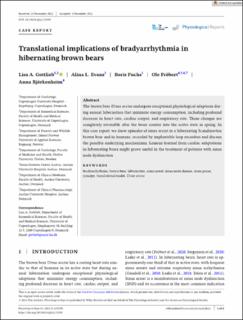Translational implications of bradyarrhythmia in hibernating brown bears
Peer reviewed, Journal article
Published version
Permanent lenke
https://hdl.handle.net/11250/3119444Utgivelsesdato
2023Metadata
Vis full innførselSamlinger
Originalversjon
10.14814/phy2.15550Sammendrag
The brown bear Ursus arctos undergoes exceptional physiological adaptions during annual hibernation that minimize energy consumption, including profound decrease in heart rate, cardiac output, and respiratory rate. These changes are completely reversible after the bears reenter into the active state in spring. In this case report, we show episodes of sinus arrest in a hibernating Scandinavian brown bear and in humans, recorded by implantable loop recorders and discuss the possible underlying mechanisms. Lessons learned from cardiac adaptations in hibernating bears might prove useful in the treatment of patients with sinus node dysfunction.

